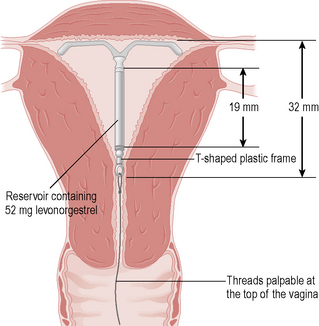9 Family planning and sexual health
Family planning
The Pearl index
The Pearl index is used to rate the effectiveness of a contraceptive method and is defined as the number of women who will become pregnant if 100 women use that form of contraception properly according to instructions for 1 year (or the percentage of women experiencing an unwanted pregnancy in 1 year of use). This is distinct from the actual failure rate, which is found with ‘typical use’ rather than ‘perfect use’ of the method. Table 9.1 shows the Pearl index for the different contraceptive options.
Table 9.1 Pearl index (the number of unwanted pregnancies per 100 women after 1 year of ‘perfect’ use of the following)
| No contraception | 80–90 |
| Male condom | 2 |
| Female condom | 5 |
| Diaphragm and cap | 4–8 |
| Combined oral contraceptive pill | < 1 |
| Progesterone-only pill | 1 |
| Injectable progestogens | < 1 |
| Progestogen implants | < 1 |
| Contraceptive patch | < 1 |
| Intrauterine contraceptive device | 1–2 |
| Levonorgestrel-releasing intrauterine system (LNG-IUS) | < 1 |
| Natural family planning | 2–6 |
| Urinary hormone kit | 6 |
| Female sterilization | 0.5 |
| Male sterilization | 0.05 |
History
The important factors to be considered in the history are:
• Previous contraceptive history and side effects or failures with contraception
• Gynaecological problems: heavy or painful periods, ectopic pregnancy or functional ovarian cysts
• Current or previous STIs and pelvic inflammatory disease (PID)
• Medical problems: arterial or venous disease, liver disease, diabetes, mechanical heart valves, hypertension
• Current medications: enzyme inducers and some broad-spectrum antibiotics affect the efficacy of contraceptive pills
• Likely compliance with tablets or reliable use of barrier methods
• Need for protection from STIs
• The importance to the woman of not becoming pregnant
• The male partner’s willingness to take responsibility for contraceptive use.
Barrier methods
Hormonal methods
Combined oral contraceptive pill
Types of combined oral contraceptive pill
Different ethinyloestradiol strengths are suitable for different groups:
• Low-strength (20 μg): suitable for women with circulatory risk factors, such as venous thrombosis or arterial disease risks.
• Standard-strength (30 or 35 μg): suitable for most women.
• High-strength (50 μg) (no longer licensed): previously used in obese women, those with breakthrough bleeding or on enzyme-inducing medication.
Thrombosis risk with the combined oral contraceptive pill
The risk of thrombosis is increased by COCP use, but is far less than the risk of thrombosis in pregnancy. The rate of thrombosis per 100 000 women per year is shown in Table 9.2.
Table 9.2 Rate of thrombosis per 100 000 women per year of combined oral contraceptive use
| Previously healthy non-pregnant, non-pill-taking woman | 5 |
| Woman taking second-generation COCP | 15 |
| Woman taking third-generation COCP | 25 |
| Pregnant woman | 60 |
COCP, combined oral contraceptive pill.
Progesterone-only pill
The progesterone-only pill (POP) is also known as the mini-pill.
Injectables and implants
Intrauterine devices
Natural family planning
Time in cycle
Ovulation occurs 12–16 days before a period.
Pain from ovulation and breast changes are less reliable indicators of fertility.







